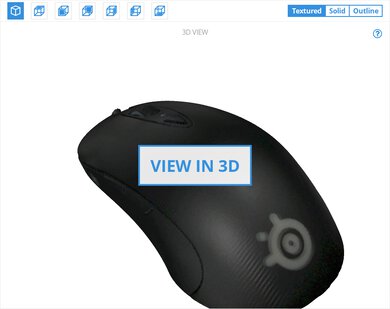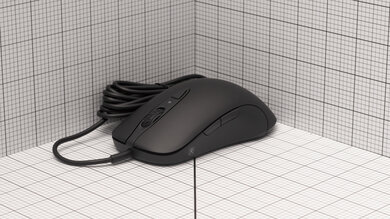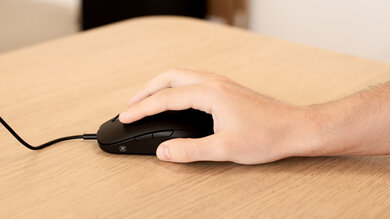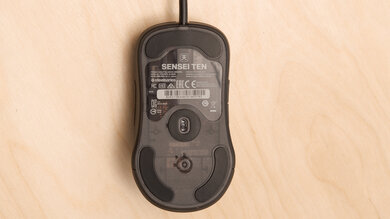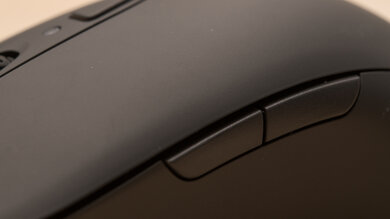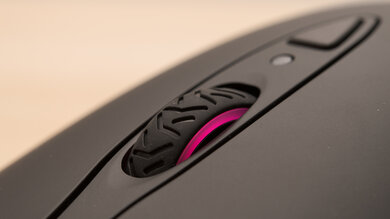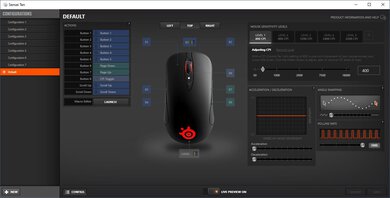The SteelSeries Sensei Ten is a great wired gaming mouse. It has excellent performance and has a very wide, customizable CPI range. It has buttons on both the left and right sides and has a symmetrical shape, making it ambidextrous. Each of the ten buttons are fully programmable with the SteelSeries Engine 3. Unfortunately, the mouse can feel slippery, and the cable has noticeable stiffness. On the upside, any hand size should be able to easily reach all the buttons when using claw grip, while only small and medium hands will have a difficult time with fingertip grip.
Our Verdict
The SteelSeries Sensei 10 is a decent mouse for office or multimedia use. The mouse feels very center-weighted, and the buttons on both sides, combined with its symmetrical shape, make this mouse good for ambidextrous use. Unfortunately, there are no L/R tilt buttons on the mouse wheel, which may be a deal-breaker if you have to scroll sideways through long documents like spreadsheets.
- Buttons on both sides making it ambidextrous.
- Slippery texture.
- No L/R tilt options on mouse wheel.
The SteelSeries Sensei Ten is a great mouse for FPS video games. The mouse is quite lightweight, and all of its buttons can be programmed, including the up/down scrolls. The sensor performance is excellent, and because it's wired, the click latency is also good. Unfortunately, small and medium hands may have a tough time with the fingertip grip.
- Good click latency.
- All buttons can be programmed, including the mouse wheel.
- Excellent software with SteelSeries Engine 3.
- Stiff cable with kinks when opened.
- Slippery texture.
The SteelSeries Sensei Ten is a great mouse for gaming because it has more buttons than typical mice, but not as many as designed MMO mice. It has exceptional software with the SteelSeries Engine 3 and all of its inputs are programmable. It has a good comfort of use but can feel slippery, especially if you have small hands and are using a palm grip. However, the buttons are easy to reach and are available on both sides of the mouse.
- Good click latency.
- All buttons can be programmed, including the mouse wheel.
- Excellent software with SteelSeries Engine 3.
- Stiff cable with kinks when opened.
- Slippery texture.
The SteelSeries Sensei 10 is a good ultra-light gaming mouse. It's light for a wired mouse, especially if you bungee the cable. Also, because it's wired, the click latency is good. Unfortunately, the cable can be quite stiff and still has kinks once opened.
- Good click latency.
- All buttons can be programmed, including the mouse wheel.
- Excellent software with SteelSeries Engine 3.
- Stiff cable with kinks when opened.
- Slippery texture.
Because the SteelSeries Sensei 10 is a wired gaming mouse, travel isn't something that needs to be considered. However, the mouse is well-built and sturdy enough to travel with if you need to.
Changelog
- Updated Dec 09, 2022: We've converted this review to Test Bench 1.2. This update simplifies our Weight test and expands on our CPI test from Test Bench 1.1, resulting in changes to test results in both sections. For more details, you can see our complete changelog here.
- Updated Nov 17, 2022: We've converted this review to Test Bench 1.1. This update revamps our Click Latency test and results in changes to test results. For more details, you can see our full changelog here.
- Updated Oct 15, 2020: Converted to Test Bench 1.0.
- Updated Jun 23, 2020: Review published.
Check Price
Differences Between Sizes And Variants
We reviewed the standard SteelSeries Sensei 10 mouse, but there's a SteelSeries Ten Neon Rider variant available in collaboration with Counter-Strike: Global Offensive. Our review and test results are valid for both of these.
Popular Mouse Comparisons
The SteelSeries Sensei 10 has a well-built symmetrical design, with buttons on both sides, making it different compared to most other FPS mice. It's a fairly straightforward gaming mouse and is light enough for ultra-light gaming. Check out our recommendations for the best wireless gaming mice, or if you're looking for a mouse that's not entirely dedicated to gaming, see our picks for the best mice and the best wireless mice.
Both the SteelSeries Rival 600 and the SteelSeries Sensei Ten are great gaming mice. The Sensei Ten includes ten programmable buttons, while the Rival 600 only has nine. Both are comfortable, but unfortunately, the Rival 600 may not suitable for people with small hands, as they may have a hard time reaching some of the buttons.
The SteelSeries Sensei Ten and the SteelSeries Rival 3 are two similar mice, but the Rival 3 is a tad bit better. The Sensei Ten suffers from a somewhat slippery texture and is a bit heavier, making the Rival 3 a better option if you prefer lighter mice. Both come with the excellent SteelSeries Engine 3 software, which allows great performance and lighting customization.
The SteelSeries Sensei RAW is an earlier version of the SteelSeries Sensei Ten, and the two have nearly identical shapes. The Sensei Ten has a wider CPI range and a set CPI that you can adjust more precisely. On the other hand, the Sensei RAW has a lower lift-off distance. Both mice are ideal for claw grip and suitable for larger hands using a fingertip or palm grip.
The SteelSeries Rival 310 and the SteelSeries Sensei Ten are two great gaming mice that perform very similarly. They both weigh about the same, have similar sizes, and are well-suited for most hand sizes using a palm or a claw grip. That said, the Rival 310 has a right-handed slant, while the Sensei Ten has an ambidextrous shape with two side buttons on both sides. The Sensei Ten also has a slightly better sensor with a wider CPI range that you can adjust more precisely and less CPI variation.
Test Results

The SteelSeries Sensei Ten has a similar shape to that of the SteelSeries Rival 3, but feels slippery and lacks grips on either side of the mouse. It has an ambidextrous frame with two buttons on both the left and right sides. It comes with RGB lighting on the SteelSeries logo and the scroll wheel.
Because the SteelSeries Sensei 10 is a wired mouse, portability isn't an issue, especially considering most people will use it at home with their gaming setup. However, if you were to travel with it, it might be difficult to fit into a laptop bag because of how tall it is. The cable can also be an issue with its solid rubbery texture. If you'd prefer a more travel-friendly mouse, check out the SteelSeries Rival 3 Wireless.
The SteelSeries Sensei Ten has a good comfort of use. The mouse feels very center-weighted, and the buttons on both sides combined with its symmetrical shape make this mouse good for ambidextrous use. However, because it's so slippery, it can be difficult to use if you don't grip it the right way. If you'd prefer a right-handed, slanted design that may be more comfortable for long periods of use, check out the SteelSeries Rival 710 or the Corsair HARPOON RGB PRO.
The SteelSeries Sensei Ten might not be the easiest to palm grip if you have small hands because it can feel slippery, and could struggle to reach all of the buttons and the scroll wheel. If you're interested in a mouse that's suitable for a palm grip for all hand sizes, check out the BenQ ZOWIE FK1-B.
Like many other SteelSeries mice, the Sensei Ten is designed to be used with the claw grip. Any size hand will have little problem having a comfortable hold of the mouse and reaching all the buttons. However, with extra-large hands, it's still a bit slippery.
This mouse is too big to fingertip grip for people with small or medium hands. They will have a difficult time hitting the scroll wheel and will find the mouse slippery. For a gaming mouse with similar performance that's suitable for all hand sizes using a fingertip grip, check out the Logitech G203 LIGHTSYNC.
The SteelSeries Sensei Ten is a wired-only mouse.
The cable on this mouse is slightly worse than the SteelSeries Rival 3, with an immediately noticeable stiffness. However, it's still a good quality rubber cable.
The SteelSeries Sensei Ten has four additional side buttons, giving this mouse 10 programmable buttons. The side buttons are wider and protrude a bit more than the SteelSeries Rival 3. You can program a specific profile to a button, but unfortunately, there isn't a button where you can flip back and forth between profiles. If you want a SteelSeries mouse with more programmable buttons, check out the SteelSeries Rival 500. Or, for a gaming mouse that has hot-swappable left and right-click switches, see the ASUS ROG Chakram Core.
The click latency of this mouse is very low, similar to most wired gaming mice. Even competitive gamers likely won't notice any delay or lag.
The mouse wheel is smooth and rubberized, with medium bumps when scrolling. It includes RGB lighting on the sides, and it feels softer with the more pressure that you apply. Unfortunately, it doesn't have left to right tilt buttons.
SteelSeries Engine 3 is an outstanding piece of software when paired with this mouse. It can be installed on either Windows or macOS, and you can customize every aspect of the mouse. This mouse also features on-board memory so you can save your customization options to the mouse and maintain them when switching computers. You can also adjust the angle snapping and polling rate.


